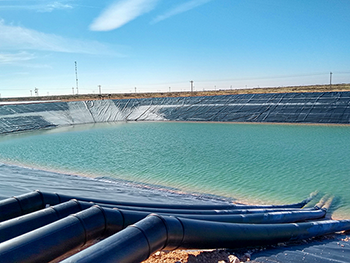NMSU Researchers Analyze Produced Water Chemistry in the Permian Basin
By Robert Sabie, Jr., NM WRRI Research Scientist
Each month NM WRRI is featuring an eNews article describing an individual research focus of the ongoing New Mexico Universities Produced Water Synthesis Project (NMUPWSP). This month we are featuring research being performed by Drs. Pei Xu, Yanyan Zhang, Kenneth Carroll, Tanner Schaub, Frank Ramos, and Jackie Jarvis at New Mexico State University (NMSU).
The extraction of oil and gas has economic benefits as well as environmental concerns, one being the management of produced water. Efforts to treat and find beneficial uses for produced water are met with fair skepticism given the constituents in the water can pose a risk to public health and the environment. Management decisions are often made using water quality parameters such as salinity, total organic carbon, and heavy metal content, however, these parameters are not enough to capture the full range of risk and toxicity of the produced water. Previous research determined there are up to 1,198 constituents identified in produced water, while only 527 of those have associated toxicity data publicly available in a database (Danforth et al. 2020). Although many of the produced water constituents are known, there is still a need for a comprehensive assessment of produced water quality and removal efficiency of treatment technologies for reducing environmental toxicity.
Researchers at NMSU are addressing this need by conducting this comprehensive assessment in their project entitled, Characterization of Produced Water in the Permian Basin for Potential Beneficial Use. Through this project, the NMSU research team is developing effective methods to analyze the organic and inorganic constituents, radionuclides, and toxicology of highly saline produced water, as well as producing a better understanding of the chemical composition and toxicity of produced water in the Permian Basin in southeastern New Mexico.
The team is collaborating with industry partners and has already completed site visits in January 2020. Analysis of the produced water quality are being performed at NMSU using advanced instrumentation such as ion chromatography (IC), inductively coupled plasma optical emission spectroscopy (ICP-OES), inductively coupled plasma mass spectroscopy (ICP-MS), agilent gas chromatography time of flight mass spectrometry (GC LECO TOF MS), Waters Acquity Ultraperformance liquid chromatography Q-TOF MS systems (LC-QTOF-MS-MS), ultrahigh resolution Orbitrap-based mass spectrometry, total organic carbon (TOC) and fluorescence excitation and emission mapping (F-EEM). In vitro tests are being performed on a mouse macrophage cell line to determine the environmental toxicity of the produced water constituents from different wells and disposal sites. The research performed in this study will help establish improved management practices, proper risk assessment, spill response, treatment, and beneficial use applications.
Reference
Danforth, W.A. Chiu, I. Rusyn, K. Schultz, A. Bolden, C. Kwiatkowski, E. Craft, An integrative method for identification and prioritization of constituents of concern in produced water from onshore oil and gas extraction, Environment international, 134 (2020) 105280.

Water storage pond for hydraulic fracturing.
